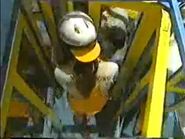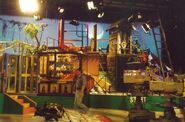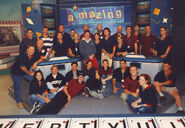| Host | |
| James Sherry | |
| Broadcast | |
| Seven Network: 16 May 1994 – 1998 | |
| Packagers | |
| Grundy Southern Star Endemol | |
A*mazing was an Australian children's television game show that aired between 1994 and 1998 on the Seven Network. It was famous for a relatively large and elaborate maze/obstacle course that was part of the show's studio set. A*mazing was hosted by James Sherry for the entire run of the series. A*mazing was produced at Channel 7 Brisbane from 1994-1996 and then at Channel 7 Perth from 1997-1998.
Format[]
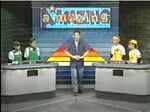
The A*mazing Set
The show pitted teams from two different primary schools against each other during the course of a week. Points gained by each pair of contestants during the week would be totaled up to decide the winning school at the end of each week.
The First Two Rounds[]
Each of these rounds was played in two parts as follows:
Part 1[]
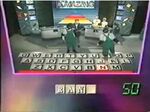
The Giant QWERTY Keyboard
In this part, a 90 second countdown timer began and the contestants had to guess the answer to a question. The host began by saying clues to the word or phrase one after another. Then he started saying first letter is (insert letter), second letter is (insert letter) and so on until the last letter. If the contestants still didn't get it, Sherry would spell the word or phrase out then say the answer. If a correct response was given, they would then have to spell out the answer by stomping out the letters on a large QWERTY keyboard mounted in the floor. If the answer had two words, they didn't need to hit the spacebar or enter key. After this, the countdown timer stopped and contestants were awarded points depending on the time taken to correctly type the answer (the time remaining determined how many points they scored, plus how long each school would have to spend in the maze during Part 2). The second school's contestants then did the same thing with the same number of letters as the first answer to make the rounds even and fair.
Each round featured a different number of letters in the answers.
Part 2[]
In this part, two contestants would enter the maze and attempt to collect the letters of the answer they had typed, which were hidden in such places as a garbage can, or behind a mock cactus. The amount of time they had to find these letters was based on how much time it took to guess and type the answer in the first round. Ten points were given for every letter they retrieved inside the maze before their time ran out.
One member of each team went inside the maze in the first round, and changed places with their partner for the second round.
Occasionally the maze would include letters that were not part of the answer. Even if they collected these, a team was not awarded any points.
Round 3[]
In this round, the contestants competed in a video game face off. During the course of the show, three different gaming platforms, all provided by sponsor Nintendo, were used. Originally the Nintendo Entertainment System (1994–1995), later the Super Nintendo Entertainment System (1995–1997), and finally, the Nintendo 64 (1997–1998).
Games played included Tetris, Bubsy, Donkey Kong Country, Donkey Kong Country 2: Diddy's Kong Quest, Super Mario World, Nigel Mansell's World Championship, Plok, Pac-Attack, 1080° Snowboarding, Donkey Kong Country 3: Dixie Kong's Double Trouble!, Wave Race 64, Super Mario Kart, Mario Kart 64, San Francisco Rush, Multi-Racing Championship, Cruis'n USA, Diddy Kong Racing, Super Mario 64, Winter Gold, Super Mario Bros. 3, Super Tennis, Cruis'n World, and the fly-swatting minigame from Mario Paint.
The team with the most points/fastest time would score 50 points for their team, while runners-up in this challenge scored 25 points for their team. Should there be a tie (e.g. both teams score the same number of coins in Super Mario Kart or hit the same number of flies in the fly-swatting minigame from Mario Paint), both teams would score 25 points each. Originally, 100 points were awarded to the winners and 50 points to the runners-up.
Known for having the fastest time ever recorded in the series, Adam Sheehan from Payne State School completed Rainbow Road in 2 minutes 5 seconds, leading his school to victory on that day.
This segment has been noted as the first televised eSports event worldwide.
After this round, the team with the highest score would then go back to the maze for 90 seconds (later changed to 120 seconds) to collect keys. If there was a tie after the third round, a sudden death question was read out to both teams in the style of the first round, and whoever answered the question correctly would technically win the game for the day.
Bonus Round[]
One player would choose which side of the maze they wanted to explore. Only when that player exited that side could the other player enter the other half of the maze. There were seven keys, including a bonus one, in the maze, and each key was worth 100 points. If either of the contestants found the bonus key, then both of the contestants would each get an original Game Boy (also provided by Nintendo), which later became a Game Boy Pocket. Only once were all seven keys found in the maze (under the 90-second time limit).
By the end of the week, the school with the highest number of points would win a grand prize, often educational computer software. Other prizes include tickets to the Wet n Wild theme park in Australia.
The Maze[]
- The only parts of the maze that remained for every series were (left to right, start to finish): the mirrored doors, the pipe, the pirate's cove, the desert, the bamboo walk, the yellow slide and the padded stairs.
- In the first series, players entering the left-hand side of the maze would run past the ball pit, into the mirrored doors, through the toy shop, through the pipe into the pirates' cove, into the desert, up the ladder, across the bamboo walk, and down the yellow slide into another ball pit.
- In the first series, players entering the right-hand side of the maze would run up the steps, past the pots, through the curved red pipe, down the stairs, into the snowstorm, up the padded stairs, past the penguins, down the ice slide and into the foam pit.
- In the second series, players entering the left-hand side of the maze would go through an aquarium, into the mirrored doors, through the toy shop, through the pipe into the pirates' cove, into the desert, up the ladder, across the jungle walk, and down the yellow slide into the ball pit.
- In the second series, players entering the right-hand side of the maze would run up the steps, past the pots, through the curved red pipe, into a thunderbox, down by the fireman's pole, get through the car, up the padded stairs, past the penguins, down the ice slide, into the pit and pass the three wheelie bins.
- In the third series, players entering the left-hand side of the maze would pass through the Swiss cheese, into the mirrored doors, through the laboratory, through the revolving pipe, into the pirates' cove, into the desert, up the ladder, across the bamboo walk, pass through three Donkey Kongs, down the slide and into the ball pit.
- In the third series, players entering the right-hand side of the maze would pass through the pet shop, up the padded stairs, go through the castle-themed platform with the zig-zag run, down the fireman's pole, through the dungeon, get through the car, and pass the luggage and the four toilets before exiting the maze.
- There was only one occasion during the entire run of the show when host James Sherry was shown to venture into the maze during the game portion of the show. During series two, one player from the winning team grabbed one key and got the key entangled in the fish net at the start of the left-hand side of the maze. After 30 seconds of trying to untangle it, James told them that the key was theirs. After the run, James ventured into the maze to count the keys they collected from the fish net.
- At one time during a maze run, at the end of the jungle walk, a contestant went over a fence and into the right-hand side of the maze.
- One of the most common locations to find the bonus key was in the car; unfortunately, most of the time, the key in the car wasn't found.
- The shortest ever maze run was 5 seconds, after one team took 85 seconds to correctly answer and type "Todd Woodbridge" (most letters to type at 14). The team managed to grab an "S", but because "S" isn't in "Todd Woodbridge", the team managed to only score 5 points (the lowest ever in a round).
- Towards the end of the show's run, parts of the set from another show on the Seven Network, Time Masters, appeared on the set of A*mazing as part of the maze. A modified version of the Zig-Zag Run (called "The Wobbly Planks" on Time Masters) from the 'BrainStrain' game appeared on the castle, and the Revolving Pipe (called "The Groove Tube" on Time Masters) replaced the green pipe at the entrance to the pirates' cove. It was also taken from the 'BrainStrain' game, which had been phased out of Time Masters after the first season, in favour of 'Slam Dunk'—which was played with a basketball instead.
- The jungle obstacle in the final season featured the Three Wise Monkeys, who were designed after Donkey Kong.
- Peter Taylor became the first ever contestant to win the major prize (the Game Boy) on A*mazing.
- Controversially, if contestants chose the left route in the maze, they had to step into a smoke-filled pit. At the base of this pit were thousands of ping pong balls. These balls sometimes made the contestants fall back onto their spine on a hard edge. The balls were removed after the first two episodes.



